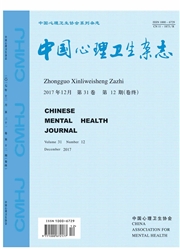

 中文摘要:
中文摘要:
目的:通过被试在倒数n项测验(n-back task)任务中的行为与事件相关电位(event-related potentials,ERP)表现,分离执行控制不同加工环节的神经电生理指标,探讨在逐步增加的记忆负荷水平下各ERP成分的时间进程及脑区分布变化规律。方法:正常成人20名参加n-back(n=0、1、2)工作记忆任务的ERP实验,同时记录行为数据及EEG脑电信号。离线处理数据后,比较被试在低、中、高工作记忆负荷下的行为表现及ERP成分的差异。结果:0、1两种记忆负荷水平下被试的反应时与正确率无显著差异,2-back任务时的正确率低于0-back与1-back[(87.7±9.9)/(98.7±2.2)、(96.3±3.5),P〈0.05],反应时长于0-back与1-back[(1077.0±247.2)/(729.5±83.7)/(837.3±144.7)msP〈0.05)]。三种记忆负荷水平的任务均诱发出了明显的P3成分。P3波幅随记忆负荷的逐步增加呈现等级下降规律,潜伏期则未随记忆负荷变化而改变。高记忆负荷与低记忆负荷的任务相减均得到一差异波N450成分,主要分布于额区及顶区。1-0及2-0差异波的N450平均波幅差异在顶区显著。结论:执行控制的注意分配、刷新、编码等成分在刺激后300ms开始,约700ms处结束。P3成分的等级下降规律反映被试有效地进行了注意的分配及转移。高负荷与低负荷差异波N450成分在额区及顶区同步出现,分别反映了执行功能中的更新与编码环节,以及短时贮存过程。
 英文摘要:
英文摘要:
Objective: To examine the effect of increasing working memory ( WM ) load on the performance and the event-related potentials elicited during a parametric executive control task in normal controls. Methods: Twenty normal aduhs performed a parametric ERP design with three levels of n-back task. They were required to remember the most recent 0, 1, or 2 digits and responded with a choice button push to whether the current target digit matched the digit presented n items previously, while the EEG was recorded during they performed the task. Results: There was no significant difference between the performance of 0-back and 1-back task. The performance of 2-back task was significant worse than those of other two tasks, expressed as lower right rate [ ( 87.7 ± 9. 9 ) / ( 98.7 ± 2. 2 ), ( 96. 3 ± 3.5), P〈0.05)] and longer response time [ (1077.0±247.2) ms (729.5±83.7) ms (837.3±144.7) msP 〈 0. 05 ) . P3 was elicited during performing all the tasks with three levels. P3 peak amplitude decreased progressively as WM load increased, while the peak latency showed no significant difference among three WM load levels. The difference wave N450 appeared at the prefrontal and posterior areas by subtraction of ERP in the lower load task from the higher load task. It was only on the parietal area that the mean amplitude of 1 -0 and 2 -0 difference wave N450 demonstrated significant difference. Conclusions: The duration from 300ms to 700ms after stimuli may be the time window of executive control process, which includes the attention distributing and switching, the information updating and coding. The progressively decreasing P3 amplitude as WM load increasing reflects the effectively distributing and switching attention in normal subjects. The difference wave N450 in prefrontal and posterior areas might reflect the up-dating and coding in executive control process and the short-term storage process, respectively and simultaneously.
 同期刊论文项目
同期刊论文项目
 同项目期刊论文
同项目期刊论文
 期刊信息
期刊信息
